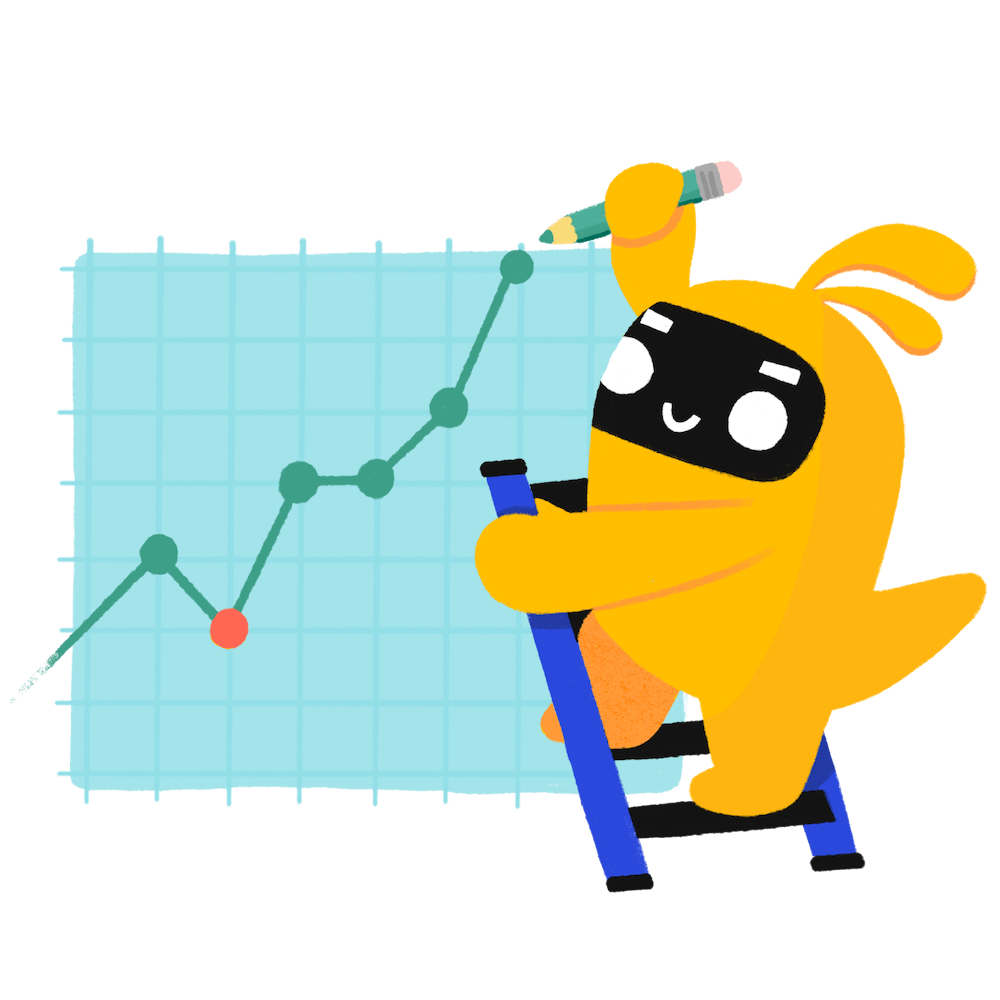7 customisable OKR examples for Engagement Improvement
What are Engagement Improvement OKRs?
The Objective and Key Results (OKR) framework is a simple goal-setting methodology that was introduced at Intel by Andy Grove in the 70s. It became popular after John Doerr introduced it to Google in the 90s, and it's now used by teams of all sizes to set and track ambitious goals at scale.
OKRs are quickly gaining popularity as a goal-setting framework. But, it's not always easy to know how to write your goals, especially if it's your first time using OKRs.
To aid you in setting your goals, we have compiled a collection of OKR examples customized for Engagement Improvement. Take a look at the templates below for inspiration and guidance.
If you want to learn more about the framework, you can read our OKR guide online.
Building your own Engagement Improvement OKRs with AI
While we have some examples available, it's likely that you'll have specific scenarios that aren't covered here. You can use our free AI generator below or our more complete goal-setting system to generate your own OKRs.
Feel free to explore our tools:
- Use our free OKR generator
- Use Tability, a complete platform to set and track OKRs and initiatives, including a GPT-4 powered goal generator
Our customisable Engagement Improvement OKRs examples
We've added many examples of Engagement Improvement Objectives and Key Results, but we did not stop there. Understanding the difference between OKRs and projects is important, so we also added examples of strategic initiatives that relate to the OKRs.
Hope you'll find this helpful!
1. OKRs to improve employee engagement in OKR setting process
Improve employee engagement in OKR setting process
Conduct at least 2 interactive workshops on OKR understanding and significance
Identify suitable speakers/experts for OKR workshops
Develop workshop content based on OKR principles
Plan and schedule two interactive OKR workshops
Survey employees to improve OKR process, aiming for 20% more positive feedback
Distribute the survey to all employees via email
Analyze responses and implement changes based on feedback
Design an anonymous survey focused on OKR process improvement
Increase employee participation in OKR setting by 30% through incentivizing contribution
Implement an incentive program for employees contributing to OKR setting
Increase communication about the significance of employees' role in OKR setting
Provide training sessions on the benefits of OKR participation
2. OKRs to boost student attendance to improve test scores
Boost student attendance to improve test scores
Increase parent-teacher communication to ensure 70% of students are consistently attending
Implement weekly update emails for parents about their child's attendance
Organize regular parent-teacher meetings to discuss attendance
Create a parent-notification system for each absence
Improve engagement in 80% of lessons to reduce truancy
Introduce reward systems to encourage attendance and participation
Implement interactive learning techniques to make lessons more engaging
Train teachers on student motivation strategies and engagement methods
Implement a reward system to motivate 90% weekly attendance rate
Announce the newly implemented reward system to the participants
Define criteria for the 90% weekly attendance rate reward system
Track attendance and distribute rewards weekly
3. OKRs to elevate campaign quality and maintain consistency across all platforms
Elevate campaign quality and maintain consistency across all platforms
Obtain a 90% satisfaction score from client feedback on campaign aesthetics
Regularly update and refine the aesthetic details as per client needs
Implement client’s suggestions and feedback in the designs
Hold brainstorming sessions about campaign's visual design improvements
Increase campaign engagement rate by 25% on all platforms
Enhance targeting efforts to reach core demographic
Utilize A/B testing to optimize engagement
Implement diverse content strategy across all platforms
Launch a minimum of 5 campaigns per platform, each exceeding previous conversion rates
Monitor and optimize campaigns to surpass old rates
Create 5 unique campaigns for each platform
Identify successful past campaigns for benchmarking
4. OKRs to improve the quality and relevancy of content through comprehensive revisions
Improve the quality and relevancy of content through comprehensive revisions
Raise positive reader feedback on revised content by 25%
Include a call-to-action encouraging readers to leave feedback
Enhance content quality through professional proofreading and editing
Implement surveys to collect readers' opinions on revisions
Increase peer reviews per article by 30% to ensure thorough evaluation
Improve training for potential reviewers
Develop and implement a new, incentivized peer-review policy
Mandate additional reviews during article submission procedure
Reduce average article revision time by 20% without compromising quality
Utilize article review templates to streamline process
Implement time-management training for article review team
Automate revising process using language editing software
5. OKRs to to strengthen relationship and engagement with practices
To strengthen relationship and engagement with practices
Achieve a 15% increase in regular communication with practices
Regularly schedule bi-weekly practice management meetings
Implement weekly email updates for ongoing practice-related events
Create an interactive feedback system for immediate responses
Implement two new collaborative projects with practices
Identify suitable practices for collaboration
Initiate contact and negotiate project details
Develop proposal for new collaborative projects
Improve satisfaction among practices by 20% as measured by a follow-up survey
Introduce new incentives for high-performing practices
Enhance communication between management and practices
Implement regular feedback sessions with practices
6. OKRs to improve communication by ensuring quarterly check-in with performance manager
Improve communication by ensuring quarterly check-in with performance manager
Implement action plan based on feedback received from performance manager
Develop a comprehensive action plan addressing the concerns highlighted
Review feedback received from performance manager thoroughly
Begin implementation of formulated action plan immediately
Discuss performance goals and feedback during check-in meeting
Review previous performance goals before the check-in meeting
Prepare constructive and specific feedback points
Schedule a check-in meeting to discuss performance goals
Schedule and attend quarterly check-in meeting with performance manager
Determine a suitable date and time for the check-in meeting
Send meeting invite to performance manager
Attend the scheduled check-in meeting
7. OKRs to optimize and excel as an innovative agile team
Optimize and excel as an innovative agile team
Reduce project turnaround time by 15% through improved team collaboration
Introduce collaboration tools for effective communication
Implement regular team meetings focusing on project obstacles
Provide training to enhance team collaboration
Obtain 90% positive feedback on project deliverables from stakeholders
Improve deliverables based on feedback received
Actively seek stakeholders' wants and needs
Continually communicate project updates to stakeholders
Increase team productivity by 25% measured by completed tasks
Introduce performance incentives for early or on-time task completion
Implement a daily morning team-meeting for task assignment and completion updates
Provide training on efficient task management and prioritizing techniques
Engagement Improvement OKR best practices to boost success
Generally speaking, your objectives should be ambitious yet achievable, and your key results should be measurable and time-bound (using the SMART framework can be helpful). It is also recommended to list strategic initiatives under your key results, as it'll help you avoid the common mistake of listing projects in your KRs.
Here are a couple of best practices extracted from our OKR implementation guide 👇
Tip #1: Limit the number of key results
Having too many OKRs is the #1 mistake that teams make when adopting the framework. The problem with tracking too many competing goals is that it will be hard for your team to know what really matters.
We recommend having 3-4 objectives, and 3-4 key results per objective. A platform like Tability can run audits on your data to help you identify the plans that have too many goals.
 Tability's audit dashboard will highlight opportunities to improve OKRs
Tability's audit dashboard will highlight opportunities to improve OKRsTip #2: Commit to weekly OKR check-ins
Setting good goals can be challenging, but without regular check-ins, your team will struggle to make progress. We recommend that you track your OKRs weekly to get the full benefits from the framework.
Being able to see trends for your key results will also keep yourself honest.
 Tability's check-ins will save you hours and increase transparency
Tability's check-ins will save you hours and increase transparencyTip #3: No more than 2 yellow statuses in a row
Yes, this is another tip for goal-tracking instead of goal-setting (but you'll get plenty of OKR examples above). But, once you have your goals defined, it will be your ability to keep the right sense of urgency that will make the difference.
As a rule of thumb, it's best to avoid having more than 2 yellow/at risk statuses in a row.
Make a call on the 3rd update. You should be either back on track, or off track. This sounds harsh but it's the best way to signal risks early enough to fix things.
How to turn your Engagement Improvement OKRs in a strategy map
Your quarterly OKRs should be tracked weekly in order to get all the benefits of the OKRs framework. Reviewing progress periodically has several advantages:
- It brings the goals back to the top of the mind
- It will highlight poorly set OKRs
- It will surface execution risks
- It improves transparency and accountability
We recommend using a spreadsheet for your first OKRs cycle. You'll need to get familiar with the scoring and tracking first. Then, you can scale your OKRs process by using a proper OKR-tracking tool for it.
 Tability's Strategy Map makes it easy to see all your org's OKRs
Tability's Strategy Map makes it easy to see all your org's OKRsIf you're not yet set on a tool, you can check out the 5 best OKR tracking templates guide to find the best way to monitor progress during the quarter.
More Engagement Improvement OKR templates
We have more templates to help you draft your team goals and OKRs.
OKRs to minimize fraudulent transactions on debit cards
OKRs to improve self-serve onboarding
OKRs to improve relationships and delivery results with internet customers and project managers
OKRs to achieve substantial operational cost reduction
OKRs to enhance and streamline stakeholder management as a developer
OKRs to meet or exceed financial and operational milestones for investor confidence
OKRs resources
Here are a list of resources to help you adopt the Objectives and Key Results framework.
- To learn: What is the meaning of OKRs
- Blog posts: ODT Blog
- Success metrics: KPIs examples
Create more examples in our app
You can use Tability to create OKRs with AI – and keep yourself accountable 👀
Tability is a unique goal-tracking platform built to save hours at work and help teams stay on top of their goals.
 1 Create your workspace
1 Create your workspace 2 Build plans in seconds with AI
2 Build plans in seconds with AI 3Track your progress
3Track your progress